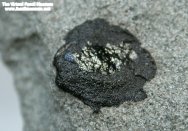Umkomasia
sp
Geological Time:
Triassic
Size: 11
mm by 9 mm on a 38 mm X 50 mm matrix
Fossil Site:
Merrywood Coal Mine, Royal Gorge, Tasmania, Australia
 Corystosperms
or fork-leafed seed ferns are a group of extinct plants with mostly
fern-like foliage but with real seeds found in the Southern Hemisphere
lands of Gondwana. The flora of Gondwana evolved in isolation from
the rest of Pangaea because of an arid desert that persisted near
the equator. The seed fern Dicroidium, like Glossopteris, occurred
across Gondwana, and thier fossils contributed to developing the
theory of Continental Drift. They possessed elaborate reproductive
structures which had their known nomenclature. The female reproductive
structures were of the Umkomasia type, while the male pollen-bearing
structures were termed Pteruchus. They serve as important index
fossils, and some data indicates that they may have persisted into
the Cretaceous when the angiosperms first appeared. Triassic plants
are fairly rare in the fossil record. Corystosperms
or fork-leafed seed ferns are a group of extinct plants with mostly
fern-like foliage but with real seeds found in the Southern Hemisphere
lands of Gondwana. The flora of Gondwana evolved in isolation from
the rest of Pangaea because of an arid desert that persisted near
the equator. The seed fern Dicroidium, like Glossopteris, occurred
across Gondwana, and thier fossils contributed to developing the
theory of Continental Drift. They possessed elaborate reproductive
structures which had their known nomenclature. The female reproductive
structures were of the Umkomasia type, while the male pollen-bearing
structures were termed Pteruchus. They serve as important index
fossils, and some data indicates that they may have persisted into
the Cretaceous when the angiosperms first appeared. Triassic plants
are fairly rare in the fossil record.
|
|